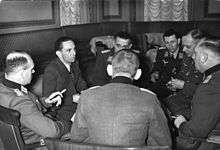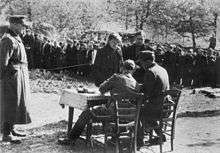Wehrmachtbericht


Wehrmachtbericht (German: "the Armed Forces report") was the daily Oberkommando der Wehrmacht (OKW) mass-media communiqué and a key component of Nazi propaganda during World War II. Produced by the Propaganda Department of the OKW (Wehrmachtpropaganda), also known as WPr), it covered the Reich's military situation and was broadcast daily on the Reich Broadcasting Corporation of Nazi Germany. All broadcasts were authorized by the Reich Ministry of Propaganda, and often failed to reflect realities on the ground.
Both civilian and military authorities considered the Wehrmachtbericht to be a vital instrument of home-front mobilization in the total war, especially after the defeat at Stalingrad. From the onset, the Nazi propaganda machine regarded these communiqués as possessing a future value, beyond the immediate use as news delivery medium. The main message consistently presented the supposed superiority of the German soldier's spirit and character. According to historian Daniel Uziel, the final 9 May 1945 communiqué contributed to the creation of the myth of the clean Wehrmacht.[1]
Production
During the war, the Wehrmachtbericht communiqué was the official news communication medium about the military situation of the Reich, and was intended for both domestic and foreign consumption.[2] The communiqué was produced by a special propaganda department attached to the Wehrmacht Führungsstab (Chief of Operation Staff) under Generaloberst Alfred Jodl. Commanded by General Hasso von Wedel, the department oversaw the growing number of propaganda companies of the Propagandakompanie, the propaganda wing of the Wehrmacht and the Waffen-SS, attached to the fighting troops.[3] A Propaganda Ministry official attended daily Wehrmacht conferences, where the initial versions of the communiqué were provided to state and party officials, and communicated them directly to Goebbels.[4]
The first communiqué aired with the start of World War II on 1 September 1939 and the last one was issued on 9 May 1945 by the Flensburg Government. Starting with 12 May 1940, Major Erich Murawski of the OKW Propaganda Department was given the task of adding commentary to them, both on the radio (21:00 to 21:15) and in the press. The commentary was aimed at the civilian audience, and were written by a professional officer in layman's language so that the population could easily grasp the daily military developments. The commentator thus had a direct line to the German public, and was versed both in the military and the propaganda realms.[5] The communiqués were read twice, the first at a normal speed, and a second time more slowly, to enable them to be transcribed by listeners.[6]
Goals
All broadcasts were authorized by Joseph Goebbels's Reich Ministry of Propaganda as controlling institution of the German media. From the beginning of the war, a central component in the activities of the propaganda troops was the preparation of combat reports to be used as source material for the OKW communiqués. The propaganda companies were the only news-reporting units able to move around in areas of military operation and gather news, as civilian news correspondents were prohibited from entering zones of military activity. Both Goebbels and Jodl considered the Wehrmachtbericht a vital instrument of home front mobilization under total war circumstances, especially after the defeat at Stalingrad. [3]
In the summer of 1941, during Operation Barbarossa, the communiqués created the image of Germany's uninterrupted successful advances deep into the Soviet territory, which were in stark contrast with deteriorating situation on the ground. After the Soviet Yelnya Offensive east of Smolensk in early September 1941, a German infantryman wrote:[7]
Officially it was called a "planned withdrawal" (...). But to me it was so much bullshit. The next day, we heard on the radio, in the 'news from the front' (Wehrmachtbericht) about the "successful front correction" in our Yelnya defensive lines and the enormous losses we inflicted on the enemy. But no single word was heard about a retreat, about the hopelessness of the situation, about the mental and emotional numbness of the German soldiers. In short, it was again a "victory". But we on the front line were running back like rabbits in front of the fox. This metamorphosis of the truth from "all shit" to "it was a victory" baffled me, and those of my comrades who dared to think.
The Wehrmacht and civilian propaganda organizations cooperated successfully and effectively throughout the war, even though several apologetic postwar publications described the relations between them as allegedly problematic, such as an account provided by Wedel.[3] Murawski, in his postwar role with as the director of the German Federal Military Archive, gave his assessment of the changes in the broadcast style of the Wehrmachtbericht: September 1939–May 1940: "cautious restraint"; Western Campaign 1940 to end of 1941: "exuberance from victories"; 1942 to Autumn 1944: "camouflage the setbacks"; Autumn 1944 to May 1945: "sober liquidation report".[8]
Stalingrad
The Wehrmachtbericht communiqués around the 1942 summer campaign and the defeat at Stalingrad provide a case study on their effects on Germany's population and the evolution of the propaganda efforts themselves. In August 1942, the Stalingrad name was featured prominently in the communiqués even before the Wehrmacht reached the outskirts of the city. The communiqués were factual and restrained; nevertheless, Goebbels issued instructions to exercise "cautious optimism" so that not to set expectations too high among the population.[9]
The Soviet offensive (Operation Uranus) broke the German flanks on 19 November and the 6th Army became trapped in Stalingrad three days later. The concern of the Nazi propaganda was then how to present this military catastrophe to the public. After the initial shock, every effort was made to hide the true scope of the setback from the population. The communiqués published between 19 and 24 November merely mentioned the Soviet attack on the southern sector in the East, not addressing the extent of Wehrmacht's difficulties.[10]
After acknowledging the Soviet breakthrough starting from 24 November on, the communiqués described "heavy fighting", but provided no references to the counteroffensive or the encirclement. The SD reports indicated that the 24 November communiqué caused alarm among the population. There were periods where the OKW dispatches did not mention Stalingrad at all. Wild rumors describing 100,000 troops trapped in Stalingrad were beginning to circulate, as some German citizens were able to get the news from foreign radio stations.[11]
The official silence was only broken on 16 January when the dispatch mentioned that the 6th Army was fighting the enemy "on all sides". Goebbels had been aware that the official policy on suppressing the news was inadequate, so he was able to convince Hitler to release the communiqué for publication. The communiqués since focused on the concept of "total war" with this message continuing through the rest of the war.[11]
Last broadcast
The final broadcast aired on 9 May 1945 and read in part:[1]
Since midnight the weapons on all the fronts are silent. By the order of the Grand Admiral Dönitz, the Wehrmacht ceased its hopeless fighting. With this, a nearly 6-year heroic struggle has ended. It brought us great victories but also heavy defeats. The Wehrmacht has been honorably defeated by superior forces. The German soldier, in accordance with his oath, has given his unforgettable effort to his people. Till the end the homeland supported him with all its strength, under the heaviest sacrifices. The singular performance of the front and Fatherland shall receive its final honor in the later, fair judgement. The achievements and sacrifices of German soldiers at sea, on the land and in the air has not escaped the notice of our enemy. Therefore, every soldier can hold his head high, and proudly lay his weapon down. He can start to work bravely and confidently the bitterest hour of our history, for the eternal life of our people.
Those words were intended for public consumption by the now defeated nation. According to historian Daniel Uziel, in this final radio address, the Wehrmacht propagandists hoped to set the frame of reference for the entire war effort of 1939–45. In this they were successful; the last communiqué helped lay the foundation for the legend of the "clean Wehrmacht" which lasted until the end of the 20th century among large parts of Germany's population.[1]
In print
The collected communiqués were published in 1985 and are available in German:
- Die Wehrmachtberichte 1939-1945 Band 1, 1. September 1939 bis 31. Dezember 1941 (in German). München: Deutscher Taschenbuch Verlag GmbH & Co. KG, 1985. ISBN 3-423-05944-3.
- Die Wehrmachtberichte 1939-1945 Band 2, 1. Januar 1942 bis 31. Dezember 1943 (in German). München: Deutscher Taschenbuch Verlag GmbH & Co. KG, 1985. ISBN 3-423-05944-3.
- Die Wehrmachtberichte 1939-1945 Band 3, 1. Januar 1944 bis 9. Mai 1945 (in German). München: Deutscher Taschenbuch Verlag GmbH & Co. KG, 1985. ISBN 3-423-05944-3.
See also
- Nazi propaganda
- Signal, a magazine published by the Wehrmacht
- Waffen-SS in popular culture
References
Citations
- 1 2 3 Uziel 2008, p. 339.
- ↑ Kallis 2005, p. 56.
- 1 2 3 Yad Vashem.
- ↑ Kallis 2005, p. 57.
- ↑ Uziel 2008, p. 270.
- ↑ Von Krockow, Christian (1992). The Hour Of The Women (First ed.). London: Harper Collins. p. 23. ISBN 0-571-14320-2.
- ↑ Stahel 2009, pp. 412–413.
- ↑ Murawski, Erich (1962): p. 123
- ↑ Uziel 2008, p. 296.
- ↑ Uziel 2008, p. 298.
- 1 2 Uziel 2008, p. 298-99.
Bibliography
- Kallis, A. (2005). Nazi Propaganda and the Second World War. Palgrave Macmillan. ISBN 978-1-4039-9251-2.
- Murawski, Erich (1962). Der deutsche Wehrmachtbericht 1939 - 1945, vom 1.7.1944 bis zum 9.5.1945 (in German). Boppoard am Rhein, Germany: Harald Boldt Verlag.
- Stahel, David (2009). Operation Barbarossa and Germany's Defeat in the East. Cambridge, UK: Cambridge University Press. ISBN 978-0-521-76847-4.
- Uziel, Daniel (2008). The Propaganda Warriors: The Wehrmacht and the Consolidation of the German Home Front. Peter Lang AG, Internationaler Verlag der Wissenschaften. ISBN 978-3039115327.
- Daniel Uziel. "Wehrmacht Propaganda Troops and the Jews" (PDF). Yad Vashem. Retrieved 28 December 2015.